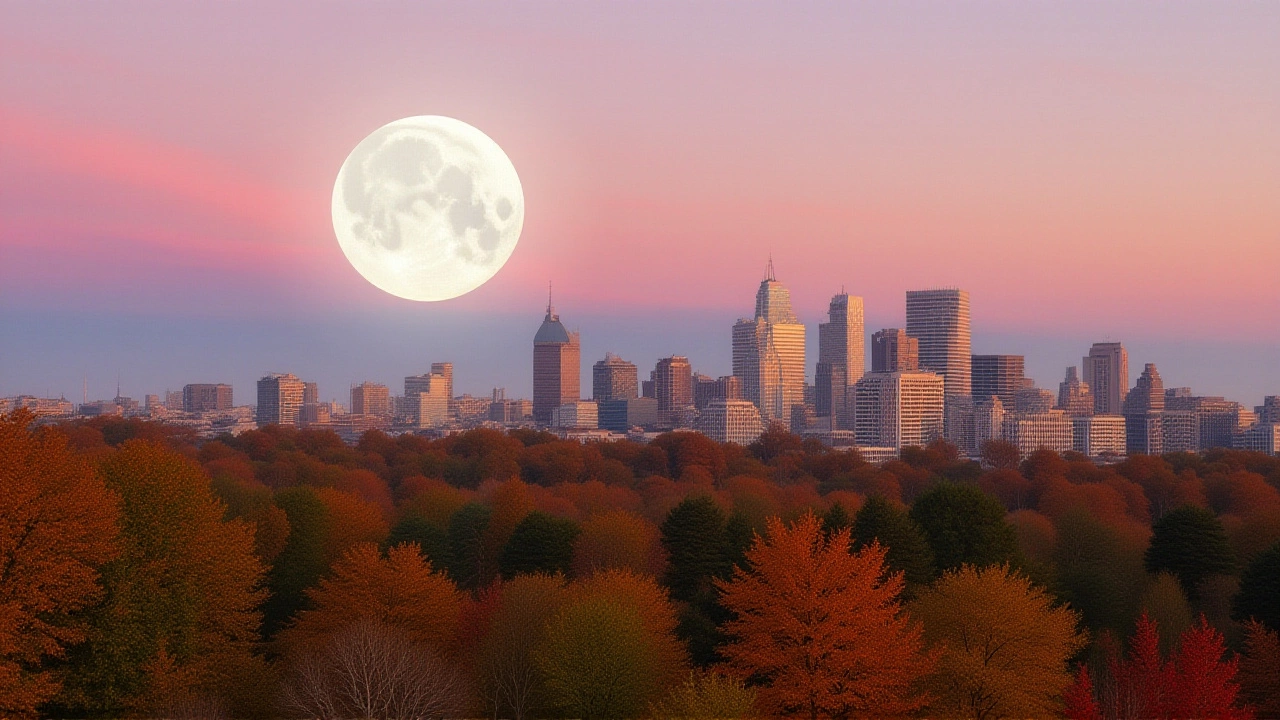When the night sky lights up on Monday, October 6, 2025, the supermoon will rise over the United States, marking the first of an unusually long‑running autumnal lunar show. The full Moon will hit its brightest point at 11:47 p.m. EST (3:47 p.m. UTC on Tuesday) and will be visible again at dusk on Tuesday, October 8, painting the eastern horizon with a larger, more luminous disk than most full moons.
What Makes This Supermoon Special
The event, officially titled October 6 2025 SupermoonNorthern Hemisphere, occurs when the Moon is at perigee — the closest point in its elliptical orbit to Earth. At perigee, the lunar diameter can swell up to 7 percent larger and its surface up to 15 percent brighter than a typical full Moon, creating a dramatically richer night‑time canvas.
NASA confirmed that the October full Moon will be the first of three consecutive autumn supermoons, a pattern that only happens roughly once every 30 years. The rarity stems from the precise alignment of the Moon’s orbital nodes with Earth’s position relative to the Sun during the autumnal months.
Historical and Cultural Context
Folklore gives this October Moon a double identity: the Harvest Moon and the Hunter’s Moon. The Harvest Moon label comes from its proximity to the September 22, 2025 autumnal equinox, making it the full Moon closest to the point when day and night are equal. Traditional agrarian societies prized the extra evening light, allowing farmers to finish gathering crops after sunset.
Meanwhile, Old Farmer’s Almanac lists the same lunar phase as the Hunter’s Moon, a name that historically signaled the start of hunting season. In the 1930s, the Almanac codified these names, and they’ve persisted in regional lore ever since.
Astronomical Details and Viewing Tips
For the casual sky‑watcher, the best time to catch the Moon at its full glory will be around sunset on Tuesday, October 8, when it will sit low on the eastern horizon. Those eager to see an extra‑lunar bonus can glance westward on Sunday, October 5, to spot the near‑full Moon rising just above Saturn, which is making one of its closest approaches to Earth this year.
Photographers should use a low‑ISO setting and a modest telephoto lens (200‑300 mm) to capture the Moon’s enhanced size without star trails. The atmosphere will be clearer in the Midwest and the Northeast, where humidity levels typically dip below 60 percent in early October.

Astrological Takeaways and Public Reaction
Celebrity astrologer Kyle Thomas weighed in with Good Morning America on Monday, noting that the bold, adventurous vibe of this Moon could spark turning points for writing, advertising, and communication projects. "Contracts that have been simmering may finally surface for negotiation or signing," Thomas said.
He went further, advising Pisces (Feb 19 – Mar 20) to keep a close eye on finances, as the Moon’s illumination can reveal the outcomes of six‑month‑long spending or saving habits. The Economic Times echoed the sentiment, highlighting that four zodiac signs may see "drastic changes" under the Moon’s influence, though the report stressed that such claims are symbolic rather than scientific.
What Comes Next: The Autumn Supermoon Series
After the October highlight, two more supermoons will grace the sky: one on November 5 and another on December 5, each aligning with perigee and full illumination. The November Moon will coincide with the Orionids meteor shower, while the December event will fall near the winter solstice, offering a spectacular “winter supermoon” that astronomers say will be the brightest of the year.
This trio gives sky‑watchers three consecutive opportunities to witness a lunar display that most people only see once a decade. Expect local astronomy clubs to host viewing parties, and social‑media feeds to light up with #Supermoon2025 photos.
Frequently Asked Questions
When is the optimal time to view the October 2025 Supermoon?
The brightest moment occurs at 11:47 p.m. EST on October 6, but the most photogenic view is at dusk on October 8 when the Moon rises on the eastern horizon. For early observers, a glance on October 5 shows an almost‑full Moon just above Saturn.
Why is this called both the Harvest Moon and the Hunter’s Moon?
The dual naming reflects regional folklore. As the Moon falls closest to the September 22 equinox, it traditionally provided extra light for harvest work, earning the Harvest Moon title. Simultaneously, the same timing signaled the start of hunting season, which is why the Old Farmer’s Almanac calls it the Hunter’s Moon.
How does a supermoon differ from a regular full moon?
A supermoon happens when the Moon is at perigee, the point in its orbit nearest to Earth. This makes the lunar disk appear roughly 7 percent larger and up to 15 percent brighter than a typical full Moon, creating a noticeably more vivid night‑time spectacle.
What should amateur astronomers bring to a viewing party?
A pair of binoculars or a modest telephoto lens (200‑300 mm) is enough to notice the Moon’s increased size. Dress in layers, bring a sturdy chair, and consider a low‑light red flashlight to preserve night vision while checking star charts.
Will the October Supermoon affect tides?
Yes. Because the Moon is at perigee, its gravitational pull is slightly stronger, leading to marginally higher than average spring tides along coastlines. However, the difference is generally a few inches and not a concern for most coastal activities.
